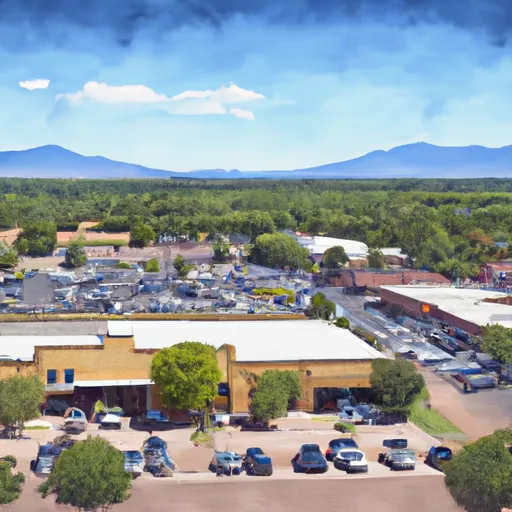-
 Snoflo Premium
Snoflo Premium
Get unlimited access to all our content
With no Ad interruptions! - Start Your Free Trial Login with existing account
Many-Farms
Eden Index
Climate
8.7
•
Recreation
•
Community
1.2
•
Safeguard
3.8/10

Many-Farms is a small community located in Apache County, Arizona. It experiences a semi-arid climate characterized by hot summers and mild winters. Summers can be scorching, with temperatures often reaching over 90°F (32°C), while winters are relatively mild, with temperatures seldom dropping below freezing. The area receives an average annual rainfall of around 10 inches (250 mm), with the majority occurring during the summer monsoon season.
Hydrologically, Many-Farms is situated near the Chuska and Lukachukai Mountains, which provide the primary sources of surface water for the region. The area is also rich in groundwater resources, with the Navajo Aquifer system providing essential water supplies.
Outdoor recreation opportunities in Many-Farms are abundant. The nearby Chuska Mountains offer hiking trails that lead to breathtaking vistas and scenic landscapes. Fishing enthusiasts can enjoy angling for trout in the streams and lakes found in the surrounding area. Additionally, the community is close to the Canyon de Chelly National Monument, which provides opportunities for camping, rock climbing, and exploring ancient Native American ruins.
Overall, Many-Farms, Arizona offers a diverse climate, access to vital hydrological resources, and numerous outdoor recreation opportunities, making it an appealing destination for nature lovers and adventure seekers.
What is the Eden Index?
The Snoflo Eden Index serves as a comprehensive rating system for regions, evaluating their desirability through a holistic assessment of climate health, outdoor recreation opportunities, and natural disaster risk, acknowledging the profound impact of these factors on livability and well-being.
Climate Health Indicator (CHI): 8.7
Many-Farms receives approximately
190mm of rain per year,
with humidity levels near 64%
and air temperatures averaging around
12°C.
Many-Farms has a plant hardyness factor of
6, meaning
plants and agriculture in this region thrive during a short period during spring and early summer. Most
plants will die off during the colder winter months.
By considering the ideal temperature range, reliable water supplies, clean air, and stable seasonal rain or snowpacks, the Climate Health Indicator (CHI) underscores the significance of a healthy climate as the foundation for quality living.
A healthy climate is paramount for ensuring a high quality of life and livability in a region, fostering both physical well-being and environmental harmony. This can be characterized by ideal temperatures, reliable access to water supplies, clean air, and consistent seasonal rain or snowpacks.
Weather Forecast
Streamflow Conditions
Lower San Juan
Area Rivers
Lower San Juan
Snowpack Depths
Lower San Juan
Reservoir Storage Capacity
Lower San Juan
Groundwater Levels
Recreational Opportunity Index (ROI):
The Recreational Opportunity Index (ROI) recognizes the value of outdoor recreational options, such as parks, hiking trails, camping sites, and fishing spots, while acknowledging that climate plays a pivotal role in ensuring the comfort and consistency of these experiences.
Access to outdoor recreational opportunities, encompassing activities such as parks, hiking, camping, and fishing, is crucial for overall well-being, and the climate plays a pivotal role in enabling and enhancing these experiences, ensuring that individuals can engage in nature-based activities comfortably and consistently.
Camping Areas
| Campground | Campsites | Reservations | Toilets | Showers | Elevation |
|---|---|---|---|---|---|
| Cottonwood - Canyon de Chelly National Monument | 104 | 5,525 ft |
Nearby Ski Areas
Catastrophe Safeguard Index (CSI):
The Catastrophe Safeguard Index (CSI) recognizes that natural disaster risk, encompassing floods, fires, hurricanes, and tornadoes, can drastically affect safety and the overall appeal of an area.
The level of natural disaster risk in a region significantly affects safety and the overall livability, with climate change amplifying these risks by potentially increasing the frequency and intensity of events like floods, fires, hurricanes, and tornadoes, thereby posing substantial challenges to community resilience and well-being.
Community Resilience Indicator (CRI): 1.2
The Community Resilience Indicator (CRI) recognizes that education, healthcare, and socioeconomics are crucial to the well-being of a region. The CRI acknowledges the profound impact of these elements on residents' overall quality of life. By evaluating educational resources, healthcare accessibility, and economic inclusivity, the index captures the essential aspects that contribute to a thriving community, fostering resident satisfaction, equity, and social cohesion.

